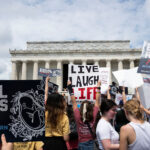
Published October 21, 2021
In his fascinating new book, Hegel’s Century, intellectual historian Jon Stewart comments that Hegel’s Lectures on the Philosophy of Religionends on an uncharacteristically dour note: Hegel writes that the 1820s witnessed a rise in anxiety and despair because cultural symbols and institutions began to lose their meaning, plunging the world into a state of random flux. Of course, this is all the more true of our own world, where old symbols—national flags, national anthems, national narratives—have lost their shared meaning, and have thus also lost their authority. Which flag to fly—Stars and Stripes or Pride? Which anthem to sing—“Star Spangled Banner” or “Lift Every Voice and Sing”? Where to date America’s founding—1776 or 1619? These are now serious questions.
For Christians, this flux is not too surprising. Here we have no lasting city, as the New Testament tells us. Earthly cities come and go; the city of God remains. But what happens when the earthly presence of the city of God—the church—loses confidence in her sacred symbols?
Stewart’s book arrived on the same day I noticed a courageous article by Mary Frances Myler, an undergraduate at Notre Dame, on her university’s approach to LGBTQ activism. The article’s existence should be a rebuke to the officer class of American Christianity, so many members of which remain silent on such issues. As Rod Dreher observed, the article highlights the pitiful leadership of the church, one incapable of withstanding what is to come. Yet here is a young woman potentially risking her career and more in order to stand for truth and state the obvious: Christianity and Pride activism cannot be reconciled.
The article features a striking picture of a Catholic priest wearing a rainbow stole at a Coming Out Day Celebration on Notre Dame’s campus. Myler quotes the priest: “My presence at this event was simply to affirm, support, and celebrate the dignity of every human person as a child of God. We prayed in gratitude for the unique gift that every person is [and] for an end to discrimination.”
The priest was no doubt sincere in this. But his personal motives are of little significance compared to the rainbow-colored stole that he wore: It is a deathwork. And deathworks are just as lethal to the faith as any explicit denial of Christian teaching.
“Deathwork” is a term used by sociologist Philip Rieff. It refers to the act of using the sacred symbols of a previous era in order to subvert, and then destroy, their original significance and purpose. Rieff uses Andres Serrano’s notorious 1987 picture Piss Christ to illustrate this. The work is a photograph of something considered sacred—in this case a crucifix—submerged in the artist’s own urine. As Rieff puts it, in Serrano’s photo the sacramental has been made excremental. Or, to borrow a phrase from Marx— that which was holy has been profaned.
So how is the priest’s stole a deathwork? To Jews and Christians, the rainbow has sacred significance. In the Bible, God places a rainbow in the sky after Noah’s flood as a sign of his covenant promise not to wipe humanity from the earth in another act of judgment. It is a sacred sign—just as circumcision, baptism, and the Lord’s Supper also have powerful, holy significance.
It is one thing for someone unaware of the biblical narrative and the sacred significance of the rainbow to adopt it as a sign. This is likely the case for many LGBTQ individuals. To them, the rainbow signifies the spectrum of identities that their alliance contains, and is therefore a symbol of inclusion. But it is quite another thing for Christians, especially priests and ministers, to use the rainbow as a means of acknowledging the LGBTQ movement—or to express any level of solidarity with it, especially in a religious context. Such actions are deathworks, the willing subversion of the sacred in the service of the profane. The priests and ministers who perform them are simply helping the church become just like our world: a place where the sacred symbols that give church life meaning are degraded and parodied until nothing but chaos remains, and the things intended to remind Christians of God’s faithfulness become objects of ridicule. No Christian, let alone a priest or minister, should be involved in such evil.
Long ago, Nietzsche’s Madman asked the rhetorical question, “What after all are these churches now if they are not the tombs and sepulchers of God?” Sadly, it seems that too many of the gravediggers these days are members of the clergy.
Carl R. Trueman is a Fellow at the Ethics and Public Policy Center.
Carl R. Trueman is a fellow in EPPC’s Evangelicals in Civic Life Program, where his work focuses on helping civic leaders and policy makers better understand the deep roots of our current cultural malaise. In addition to his scholarship on the intellectual foundations of expressive individualism and the sexual revolution, Trueman is also interested in the origins, rise, and current use of critical theory by progressives. He serves as a professor at Grove City College.










